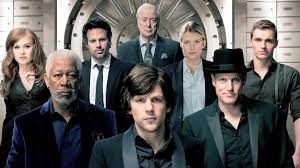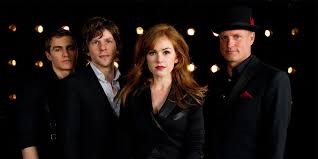*Now You See Me* isn’t just about flashy tricks—it’s a masterclass in psychological manipulation. Illusions in the film exploit cognitive biases like selective attention, where the brain focuses on one detail while ignoring others. For instance, magicians use “misdirection” to divert your gaze, just as Daniel Atlas (Jesse Eisenberg) does in the movie. Neuroscientists explain that magic tricks activate the brain’s reward centers, creating awe and curiosity. By blending storytelling and sensory overload, *Now You See Me* mirrors how real-life magicians hijack perception, proving that seeing isn’t always believing.

Top 10 Magic Tricks from *Now You See Me* (And How They Work)**
From the opening card-throwing sequence to the climactic helicopter heist, *Now You See Me* delivers jaw-dropping illusions. The “Rainmaker” bank heist relies on holographic projections and coordinated timing, while Merritt’s (Woody Harrelson) mentalist acts use cold reading and psychological profiling. The underwater escape scene combines CGI with practical effects, like hidden air tanks. While some tricks are Hollywood magic, others, like sleight-of-hand card maneuvers, are rooted in real techniques. The film’s blend of realism and fantasy keeps audiences guessing—a hallmark of *Now You See Me*’s enduring appeal.
From Fiction to Reality: Real-Life Heists Inspired by *Now You See Me***
The movie’s audacious heists aren’t purely fictional. In 2013, thieves used laser technology to rob a Berlin museum, echoing the Horsemen’s high-tech tactics. Similarly, social engineering scams, like phishing or impersonation, mirror the psychological ploys in. The film’s portrayal of teamwork and precision has even inspired fan theories about real-world magic gangs. While no one’s replicated the “Rainmaker” yet, the line between cinematic fantasy and criminal ingenuity remains blurry—proving that *Now You See Me*’s allure lies in its plausibility.
Behind the Scenes of *Now You See Me*: CGI vs. Practical Magic
Creating *Now You See Me*’s illusions required a mix of cutting-edge CGI and old-school practicality. The card-throwing scenes used green screens and digital enhancements, while sleight-of-hand tricks were performed live by magicians like David Kwong. Director Louis Leterrier prioritized authenticity, hiring illusion consultants to train the cast. For instance, Eisenberg spent months mastering card flourishes. Yet, some stunts, like the helicopter escape, relied on visual effects. This hybrid approach ensures feels both grounded and fantastical—a balance that defines its visual identity.
How to Master Sleight of Hand: Lessons from *Now You See Me* Experts**
Want to learn sleight of hand? Start with the basics: palming, false shuffles, and controlled cuts—all showcased in *Now You See Me*. Professional magicians advise practicing in front of a mirror to perfect angles. Eisenberg’s training emphasized finger dexterity and timing, key to making tricks seamless. Props like weighted cards or magnetic devices, used in the film, can aid beginners. Remember, confidence sells the illusion. As the movie’s tagline says, “The closer you look, the less you see”—a mantra for aspiring magicians.
Now You See Me* Easter Eggs: Hidden Clues You Missed in the Movies**
Sharp-eyed fans spot Easter eggs that foreshadow twists. In the first film, billboards hint at the Eye’s identity, while tarot cards in 2* reference upcoming plot points. The recurring motif of “eyes” (posters, logos) symbolizes surveillance and hidden agendas. Even the Horsemen’s code names—like “The Lovers” or “The Hermit”—tie into tarot symbolism. These details reward rewatches, embedding *Now You See Me* deeper into pop culture.
The Art of Misdirection: *Now You See Me* Techniques Used by Pro Magicians**
Misdirection is the backbone of magic, and *Now You See Me* exemplifies it. Pro magicians use verbal distractions, flashy movements, or props to shift attention. For example, Jack Wilder’s (Dave Franco) coin tricks hide his true actions. Similarly, mentalists like Merritt exploit confirmation bias, making vague statements feel personal. The film’s heists use grand spectacles (explosions, light shows) to mask smaller, critical actions—proving that magic lies in what you *don’t* notice.
Why *Now You See Me* Revolutionized Hollywood’s Portrayal of Magic**
Before *Now You See Me*, magic films often focused on solo performers (e.g., *The Prestige*). This franchise reimagined magic as a team sport, blending heist thrills with illusion. Its global success ($700 million worldwide) spurred studios to greenlight magic-themed projects like *The Incredible Burt Wonderstone*. By merging genres and emphasizing spectacle, *Now You See Me* reshaped how Hollywood views magic—not as niche, but as blockbuster material.

DIY Magic Tricks: Recreate *Now You See Me* Illusions at Home**
Channel your inner Horseman with DIY tricks. The “floating card” illusion uses invisible thread, while the “mind-reading” gag relies on pre-arranged signals. For the “bank vault” trick, hide a small box inside a larger one. Use apps to simulate holograms or QR codes, mirroring the film’s tech-driven magic. *Now You See Me* proves that creativity trumps budget—perfect for aspiring home magicians.
Now You See Me 3*: Predictions, Theories, and What We Know So Far**
The third installment, set for 2025, promises new Horsemen and higher stakes. Rumors suggest a plot involving AI-driven illusions or a global treasure hunt. Original cast members like Eisenberg and Harrelson are confirmed, alongside newcomers. Will the Eye’s identity finally be revealed? Fans speculate about time travel or meta-commentary on modern surveillance. One thing’s certain: *Now You See Me 3* will keep audiences spellbound.
Conclusion**
*Now You See Me* transcends typical heist or magic films by merging psychology, technology, and artistry. Its illusions challenge perception, while its storytelling rewards curiosity. From inspiring real-world tricks to redefining Hollywood magic, the franchise leaves a legacy as enigmatic as its twists. As we await the third film, remember: the greatest magic isn’t onscreen—it’s how *Now You See Me* makes us believe the impossible.
FAQs
Are the magic tricks in *Now You See Me* real?**
A1: Some are based on real techniques (sleight of hand), while others use CGI or practical effects.
Who is the real “Eye” in the franchise?**
A2: The films intentionally keep the Eye’s identity ambiguous to maintain mystery.
Did professional magicians work on *Now You See Me*?**
A3: Yes, consultants like David Kwong ensured authenticity in the tricks and performances.
Is *Now You See Me 3* confirmed?**
A4: Yes! Filming is underway, with a planned 2025 release.
Can I learn the card tricks from the movie?**
A5: Absolutely—many tutorials online break down the sleight-of-hand techniques.
What’s the “Rainmaker” heist based on?**
A6: It’s fictional but inspired by real tech like holograms and social engineering.
Why is misdirection so important in magic?**
A7: It redirects attention, allowing magicians to execute tricks unnoticed.
Are there real magician groups like the Horsemen?**
A8: While no exact equivalents exist, teams like Penn & Teller showcase collaborative magic.
How did the cast prepare for their roles?**
A9: They trained with magicians for months to master card tricks and mentalist tactics.
What’s the biggest Easter egg in the films?**
A10: The recurring “eye” motif, symbolizing the omnipresent, mysterious overseer.